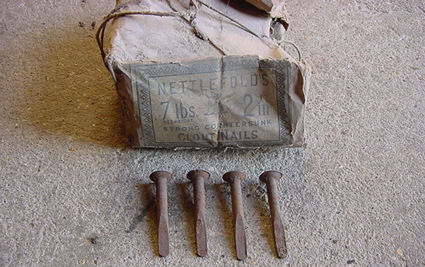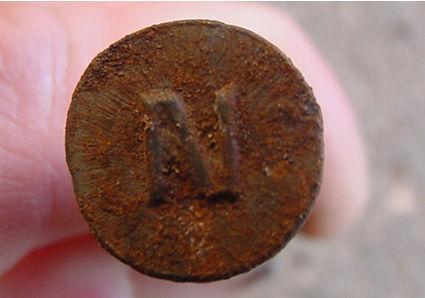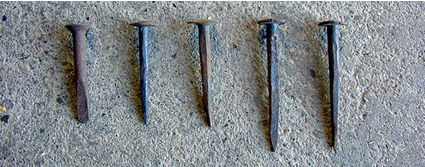HISTORIC IRONWORK REPAIRS IN TIMBER-FRAMED BUILDINGS.
Chapter 7.
7. The origins of nails, staples, screw fixings and bolts. 3/6
Round section nails, known commonly as wire nails, were invented in France c.1830 and had ground points and hand-made heads. They were uncommon outside France until c.1855 when machines were invented to make a complete 'French nail' automatically. However it is not until about 1890 that wire nails outnumbered cut nails in production volume and variety.
Heavy round nails are known as clouts (Fig 7.9) and these are commonly used to secure late 19th century ironwork repairs. In the 20th century they too carried makers marks forged in the heads. (Fig 7.10).
Fig 7.9. Round section clout nails from the early 20th century still with their original box. These are used in late Victorian repairs onwards.
Fig 7.10. The stamped head of a modern clout nail.
Wire nails have the poorest mechanical qualities in respect to splitting timber and it is preferable to drill the uppermost timber to receive the shank without splitting out. Modern low-quality timber and methods of timber construction almost completely obviate the use of a hammer and nail. Nail guns are however popular and their impact power prevents the splitting problem.
A chronology of nail types is given by Fontana and Greenleaf 1962 after Mercer 1924 and is summarised as follows:
Pre-1800. Nails were hand-made wrought iron. This continued in volume until c1850. (Custom-made wrought-iron nails are still available).
1790-1810. A period characterised by machine-cut Type A nails, the nail plate being reversed under the cutter. Some heads are stamped but mostly hand hammered. Angle or L-headed nails appear and are used in floors and clap-boards.
1810-1825. Machines to produce Type B cut nails are invented, the work moving from side to side without being reversed. Until 1825 the heads are formed by handwork.
1825-1830. Type B production continues but water-powered hammers are used to head the nails. Heads are thin and lop-sided.
c.1830-c1855. Wire nails are invented in France (French nails). Ground points and headed by hand.
1830-c1890. Cut nails are produced in refined machines that cut and head them uniformly. Heads are thin, uniform and comparatively square. Cut nails outnumber all other varieties.
c.1855-present day. Wire cut nails and produced on automatic machines in France. Exported machines are soon copied and after 1890 wire nails outnumber all other varieties.
c.1870-present day. Cut nails are annealed to prevent rupturing when clinched.
c. 1890-present. Cut nails continue to be produced for special purposes such as securing wood to cement, concrete or plaster. (i.e. skirting boards, picture rails, architrave etc) until about 1950 when they were replaced by cement coated nails. Cut nails were still common in sub-flooring and are still used today in hardwood floors.
The other type of nail which is sometimes observed being used to secure iron ties is the horse-shoe nail. This has a distinctive extended head designed to sit in the corresponding recess in a horse-shoe. As such its form appears unchanged over the centuries and unless it can be extracted and tested will be of little use for dating. Obviously it points to an equine connection and is more likely to be found in farm buildings than elsewhere which also indicates an ad hoc repair rather than a professional one.
There is a specific difficulty in using nails to date repairs in that it is necessary to extract a complete specimen to determine its characteristics. Often only the head is visible and this is not a reliable indicator. (Fig 7.11).
Fig 7.11. A selection of clout nails from the early 20th century. These came from a Wheelwrights shop at Kedington, Suffolk. The first on the left has a heavy round machine-made section with a flattened tip and is the easiest to identify. The others all have irregular shanks and are much more difficult to date.



